2021 HONDA CLARITY FUEL CELL battery
[x] Cancel search: batteryPage 7 of 555
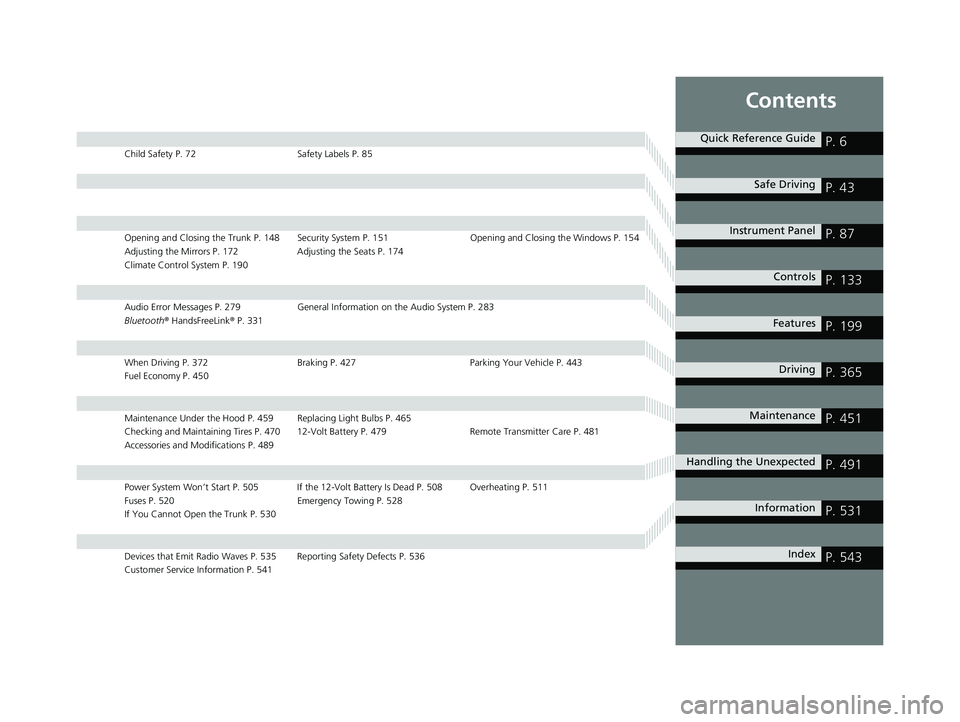
Contents
Child Safety P. 72Safety Labels P. 85
Opening and Closing the Trunk P. 148 Security System P. 151 Opening and Closing the Windows P. 154
Adjusting the Mirrors P. 172 Adjusting the Seats P. 174
Climate Control System P. 190
Audio Error Messages P. 279 General Information on the Audio System P. 283
Bluetooth ® HandsFreeLink ® P. 331
When Driving P. 372 Braking P. 427Parking Your Vehicle P. 443
Fuel Economy P. 450
Maintenance Under the Hood P. 459 Replacing Light Bulbs P. 465
Checking and Maintaining Tires P. 470 12-Volt Battery P. 479 Remote Transmitter Care P. 481
Accessories and Modifications P. 489
Power System Won’t Start P. 505 If the 12-Volt Battery Is Dead P. 508 Overheating P. 511
Fuses P. 520 Emergency Towing P. 528
If You Cannot Open the Trunk P. 530
Devices that Emit Radio Waves P. 535 Reporting Safety Defects P. 536
Customer Service Information P. 541
Quick Reference GuideP. 6
Safe DrivingP. 43
Instrument PanelP. 87
ControlsP. 133
FeaturesP. 199
DrivingP. 365
MaintenanceP. 451
Handling the UnexpectedP. 491
InformationP. 531
IndexP. 543
21 CLARITY FCV CSS-31TRT6400_02.book 5 ページ 2020年9月25日 金曜日 午後3時15分
Page 13 of 555

11
Quick Reference Guide
Characteristics of Fuel Cell Vehicles
A fuel cell vehicle (FCV) converts hydrogen gas into electricity which is used to power an electric motor. The FC (fuel cell) system comprises
of hydrogen tanks and an FC stack, as well as other components, and requires a constant supply of hydrogen fuel, and proper cooling and
ventilation to generate electricity.
The FC stack is the main power unit which comprises of a series of fuel cells joined together or “stacked” on one another. With in each fuel
cell, a process that combines hydrogen and oxygen results in an electric current which is used to not only power the motor but also charge a
High Voltage battery. This High Voltage battery provides supple mentary power to assist the FC power system when the vehicle is subjected
to heavy acceleration.
Unlike vehicles that use internal combustion engines, FC vehicles emit no harmful emissions such as CO
2 and NOx, and are thus considered
environmentally responsible. The only substance discharged from the tailpipe is water, in the form of both liquid and vapor.
FC Stack
Fuel cell power output may decline faster than usual under the following circumstances:●The vehicle is frequently used in sub-zero temperatures over extended periods of time.●The vehicle is repeatedly left in standby state for extended periods of time.●The FC system is subjected to frequent starting and stopping.●Salt water has permeated the air cleaner element.
u Replace the air cleaner element and clean the surrounding area. For details, consult an authorized Honda Clarity Fuel Cell deal er.
●The vehicle is driven extensively in areas whose air contains high levels of:
Dust
Sulfur (common to hot spring and volcanoes)
Organic solvents, e.g., paints and thinners
Amine-related substances, e.g., ammonia
Chlorinated substances, e.g., salt and snow-melting agents
u Once the vehicle is driven in a normal environment again, fuel cell power output will return over time.
In the following circumstances, power output may be temporarily limited:
●You are repeatedly accelerating and decelerating aggressively.●You are ascending a slope or driving at high altitudes above 6,562 feet (2,000 meters). 2 Driver Information Interface Wa rning and Information Messages (P106)
21 CLARITY FCV CSS-31TRT6400_02.book 11 ページ 2020年9月25日 金曜日 午後3時15分
Page 17 of 555
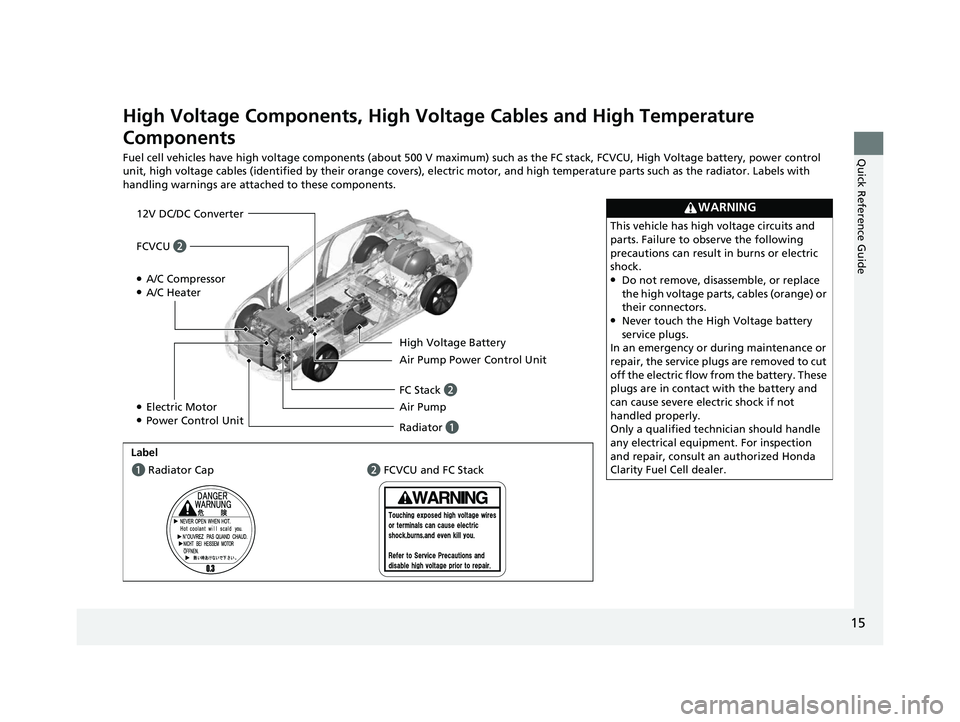
15
Quick Reference Guide
High Voltage Components, High Voltage Cables and High Temperature
Components
Fuel cell vehicles have high voltage components (about 500 V maximum) such as the FC stack, FCVCU, High Voltage battery, power control
unit, high voltage cables (identified by their orange covers), el ectric motor, and high temperature parts such as the radiator. Labels with
handling warnings are attached to these components.
WARNING
This vehicle has high voltage circuits and
parts. Failure to observe the following
precautions can result in burns or electric
shock.
●Do not remove, disassemble, or replace
the high voltage parts, cables (orange) or
their connectors.
●Never touch the High Voltage battery
service plugs.
In an emergency or during maintenance or
repair, the service plugs are removed to cut
off the electric flow from the battery. These
plugs are in contact with the battery and
can cause severe electric shock if not
handled properly.
Only a qualified technician should handle
any electrical equipment. For inspection
and repair, consult an authorized Honda
Clarity Fuel Cell dealer.
12V DC/DC Converter
●A/C Compressor●A/C Heater
Radiator a Air Pump FC Stack b Air Pump Power Control Unit High Voltage Battery
●Electric Motor●Power Control Unit
Labela Radiator Cap b FCVCU and FC Stack
FCVCU b
21 CLARITY FCV CSS-31TRT6400_02.book 15 ページ 2020年9月25日 金曜日 午後3時15分
Page 18 of 555
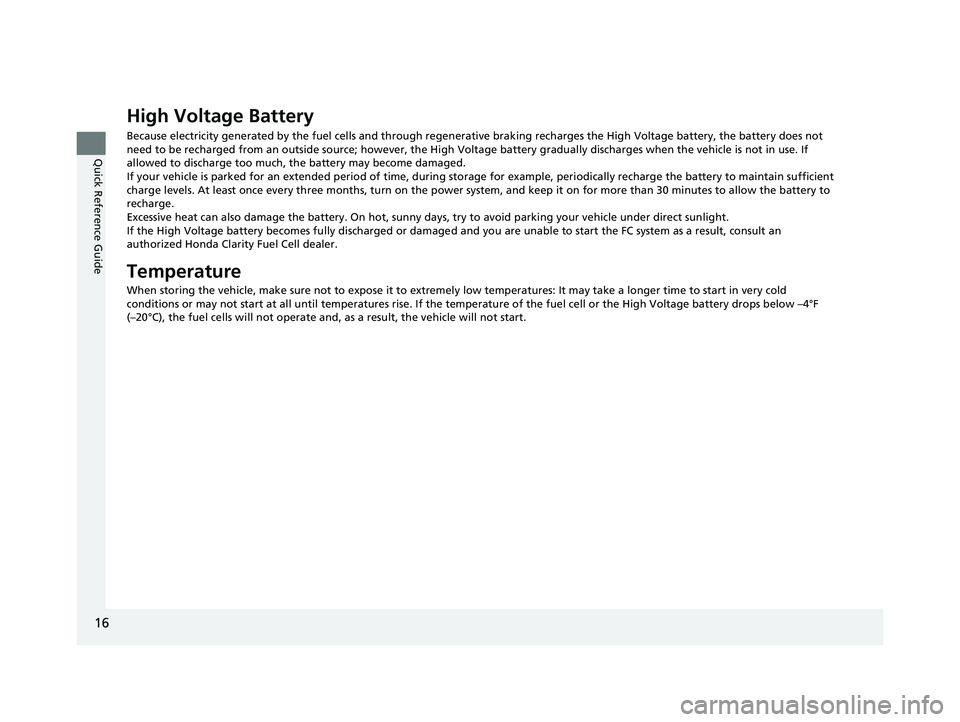
16
Quick Reference Guide
High Voltage Battery
Because electricity generated by the fuel cells and through regenerative braking recharges the High Voltage battery, the batter y does not
need to be recharged from an outside source; however, the High Voltage battery gradually discharges when the vehicle is not in use. If
allowed to discharge too much, the battery may become damaged.
If your vehicle is parked for an extended period of time, during storage for example, periodically recharge the battery to main tain sufficient
charge levels. At least once every three months, turn on the power system, and keep it on for more than 30 minutes to allow the battery to
recharge.
Excessive heat can also damage the batter y. On hot, sunny days, try to avoid parking your vehicle under direct sunlight.
If the High Voltage battery becomes fully discharged or damage d and you are unable to start the FC system as a result, consult an
authorized Honda Clarity Fuel Cell dealer.
Temperature
When storing the vehicle, make sure not to expose it to extremel y low temperatures: It may take a longer time to start in very cold
conditions or may not start at all until temperatures rise. If th e temperature of the fuel cell or the High Voltage battery drops below –4°F
(–20°C), the fuel cells will not operate and, as a result, the vehicle will not start.
21 CLARITY FCV CSS-31TRT6400_02.book 16 ページ 2020年9月25日 金曜日 午後3時15分
Page 22 of 555
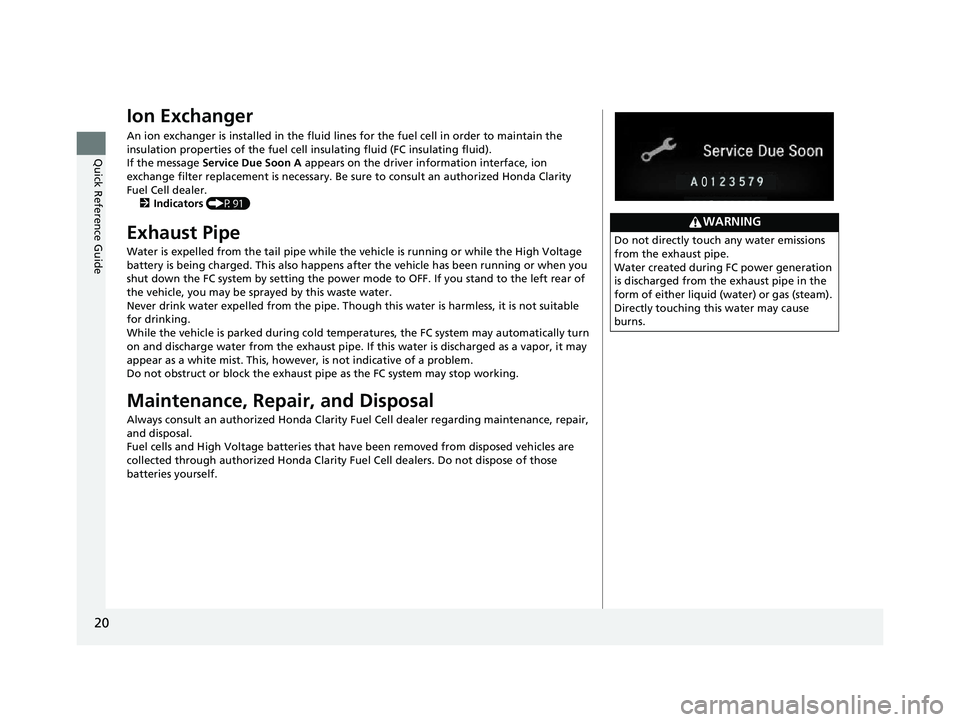
20
Quick Reference Guide
Ion Exchanger
An ion exchanger is installed in the fluid lines for the fuel cell in order to maintain the
insulation properties of the fuel cell insulating fluid (FC insulating fluid).
If the message Service Due Soon A appears on the driver information interface, ion
exchange filter replacement is necessary. Be sure to consult an authorized Honda Clarity
Fuel Cell dealer. 2 Indicators (P91)
Exhaust Pipe
Water is expelled from the tail pipe while the vehicle is running or while the High Voltage
battery is being charged. This also happens af ter the vehicle has been running or when you
shut down the FC system by setting the power mode to OFF. If you stand to the left rear of
the vehicle, you may be sprayed by this waste water.
Never drink water expelled from the pipe. Though this water is harmless, it is not suitable
for drinking.
While the vehicle is parked during cold temperatures, the FC system may automatically turn
on and discharge water from the ex haust pipe. If this water is discharged as a vapor, it may
appear as a white mist. This, however, is not indicative of a problem.
Do not obstruct or block the exhaust pi pe as the FC system may stop working.
Maintenance, Repair, and Disposal
Always consult an authorized Honda Clarity Fuel Cell dealer regarding maintenance, repair,
and disposal.
Fuel cells and High Voltage batteries that have been removed from disposed vehicles are
collected through authorized Honda Clarity Fuel Cell dealers. Do not dispose of those
batteries yourself.
WARNING
Do not directly touch any water emissions
from the exhaust pipe.
Water created during FC power generation
is discharged from the exhaust pipe in the
form of either liquid (water) or gas (steam).
Directly touching this water may cause
burns.
21 CLARITY FCV CSS-31TRT6400_02.book 20 ページ 2020年9月25日 金曜日 午後3時15分
Page 24 of 555
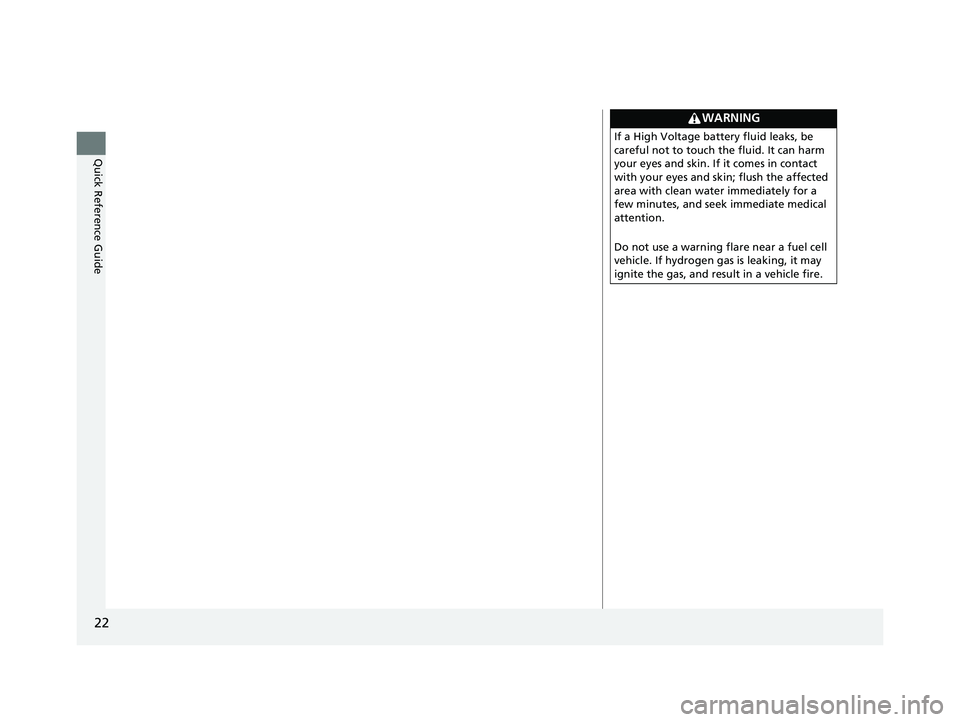
22
Quick Reference Guide
WARNING
If a High Voltage battery fluid leaks, be
careful not to touch the fluid. It can harm
your eyes and skin. If it comes in contact
with your eyes and skin; flush the affected
area with clean water immediately for a
few minutes, and seek immediate medical
attention.
Do not use a warning flare near a fuel cell
vehicle. If hydrogen gas is leaking, it may
ignite the gas, and result in a vehicle fire.
21 CLARITY FCV CSS-31TRT6400_02.book 22 ページ 2020年9月25日 金曜日 午後3時15分
Page 25 of 555
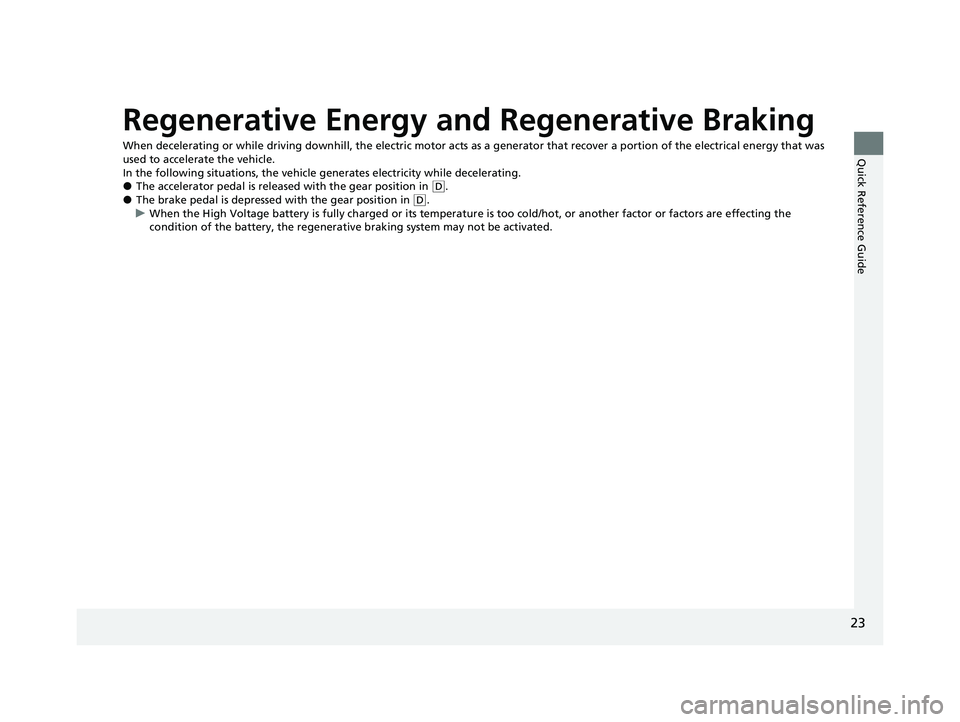
23
Quick Reference Guide
Regenerative Energy and Regenerative Braking
When decelerating or while driving downhill, the electric motor acts as a generator that recover a portion of the electrical energy that was
used to accelerate the vehicle.
In the following situations, the vehicle generates electricity while decelerating.
●The accelerator pedal is released with the gear position in (D.●The brake pedal is depressed with the gear position in (D.
u When the High Voltage battery is fully charged or its temperatur e is too cold/hot, or another factor or factors are effecting the
condition of the battery, the regenerative braking system may not be activated.
21 CLARITY FCV CSS-31TRT6400_02.book 23 ページ 2020年9月25日 金曜日 午後3時15分
Page 28 of 555
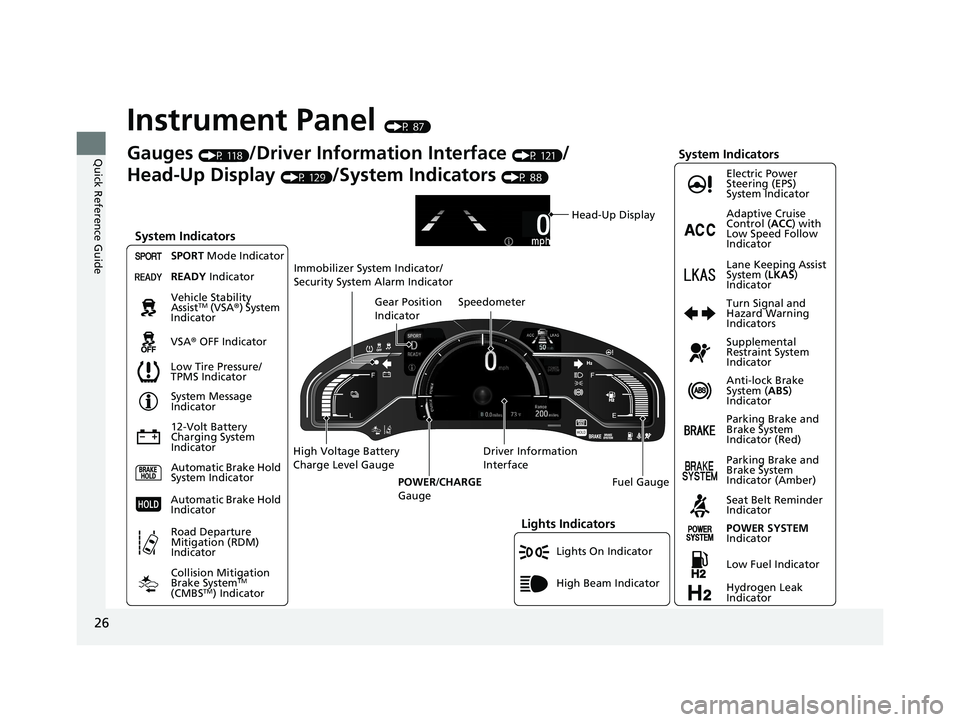
26
Quick Reference Guide
Instrument Panel (P 87)
Lights On Indicator
System Indicators
12-Volt Battery
Charging System
IndicatorAnti-lock Brake
System (
ABS)
Indicator
Vehicle Stability
Assist
TM (VSA
®) System
Indicator
VSA ® OFF Indicator Electric Power
Steering (EPS)
System Indicator
Lights Indicators
High Beam Indicator
Seat Belt Reminder
Indicator
System Indicators
System Message
Indicator
Parking Brake and
Brake System
Indicator (Red) Supplemental
Restraint System
Indicator
Gauges (P 118)/Driver Information Interface (P 121)/
Head-Up Display
(P 129)/System Indicators (P 88)
Low Tire Pressure/
TPMS Indicator Turn Signal and
Hazard Warning
Indicators
Speedometer
Automatic Brake Hold
System Indicator Parking Brake and
Brake System
Indicator (Amber)
SPORT
Mode Indicator
Collision Mitigation
Brake System
TM
(CMBSTM) Indicator
Road Departure
Mitigation (RDM)
Indicator
Immobilizer System Indicator/
Security System Alarm Indicator
Automatic Brake Hold
Indicator
Head-Up Display
READY Indicator
POWER SYSTEM
Indicator
Gear Position
Indicator
Fuel Gauge
Driver Information
Interface
High Voltage Battery
Charge Level Gauge
POWER/CHARGE
Gauge
Low Fuel Indicator
Hydrogen Leak
Indicator Adaptive Cruise
Control ( ACC) with
Low Speed Follow
Indicator
Lane Keeping Assist
System ( LKAS)
Indicator
21 CLARITY FCV CSS-31TRT6400_02.book 26 ページ 2020年9月25日 金曜日 午後3時15分